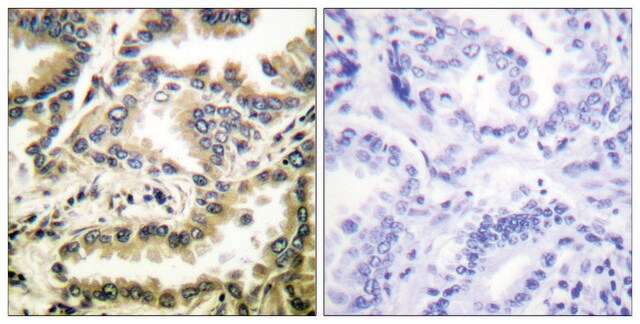CN354-05
Canine Aortic Smooth Muscle Cells: CnAOSMC (Cryovial)
About This Item
Prodotti consigliati
Origine biologica
canine aorta (normal, tunica intima and media)
Confezionamento
pkg of 500,000 cells
Produttore/marchio commerciale
Cell Applications, Inc
Modalità di accrescimento
Adherent
Cariotipo
2n = 78
Morfologia
smooth muscle
tecniche
cell culture | mammalian: suitable
Malattie correlate
cardiovascular diseases
Condizioni di spedizione
dry ice
Temperatura di conservazione
−196°C
Descrizione generale
Canine Aortic Smooth Muscle Cells (CnAOSMC) are derived from tunica intima and tunica media of normal canine aorta. They are cryopreserved at second passage and can be cultured and propagated at least 10 population doublings. Platelet-derived growth factor (PDGF) is a potent mitogen and chemotactic agent which may be involved in intimal hyperplasia and atherosclerosis. It was shown that significant regional difference in PDGF production in normal canine aorta, and that SMC are a significant contributor to the regional variation in PDGF production.
1. It was also shown that nebivolol relaxes vascular smooth muscle by NO- and cyclic GMP-dependent mechanisms.
2. Graft SMCs are functionally altered producing more platelet-derived growth factor (PDGF) than aortic SMCs. PDGF produced by graft SMCs may contribute to the development of intimal hyperplasia.
3. Graft SMCs have decreased proliferation response, but have similar migratory response to PDGF compared with aortic SMCs.
4. Intrinsic differences in endothelial cells from proximal aorta versus the distal aorta have different capacity to produce PDGF in response to stimulants whereas unstimulated SMCs did not exhibit regional variation in PDGF production and did not increase PDGF secretion after PMA or thrombin treatment.
5. Identification of the cDNA for canine isoform of nitric oxide synthase (iNOS) can be used in the study of allograft rejection and cardiovascular disease.
RECENT PUBLICATIONS Kiyan, Y., S. Tkachuk, D. Hilfker-Kleiner, H. Haller, B. Fuhrman, and Inna Dumler. 2014. oxLDL induces inflammatory responses in vascular smooth muscle cells via urokinase receptor association with CD36 and TLR4. J Molec and Cell Cardiol, 66:72-82.
Ignarro, L.J. et al, Nitric Oxide. 7(2):75-82 (2002).
Madura, J.A. et al, J. Vas Res. 33(1):53-61 (1996).
Pitsch, R.J. et al, J. Vasc. Surg. 26(1):70-8 (1997).
Minion, D.J. et al, J. Vasc. Surg. 31(5):953-9 (2000).
Van Aalst, J.A. et al, J. Vasc. Surg. 32(3):584-92 (2000).
Wang, X. et al, Am. J. Physiol. 275(4 Pt 2):H1122-9 (1998).
Products are for research use only. They are not intended for human, animal, or diagnostic applications.
Origine della linea cellulare
Applicazioni
Componenti
Nota sulla preparazione
- 2nd passage, >500,000 cells in Canine Smooth Muscle Cell Basal Medium containing 10% FBS & 10% DMSO
- Can be cultured at least 10 doublings
Mantenimento delle subcolture
Codice della classe di stoccaggio
11 - Combustible Solids
Classe di pericolosità dell'acqua (WGK)
WGK 3
Punto d’infiammabilità (°F)
Not applicable
Punto d’infiammabilità (°C)
Not applicable
Certificati d'analisi (COA)
Cerca il Certificati d'analisi (COA) digitando il numero di lotto/batch corrispondente. I numeri di lotto o di batch sono stampati sull'etichetta dei prodotti dopo la parola ‘Lotto’ o ‘Batch’.
Possiedi già questo prodotto?
I documenti relativi ai prodotti acquistati recentemente sono disponibili nell’Archivio dei documenti.
Protocolli
Technical information for working with Canine Aortic Smooth Muscle Cells including thawing, subculturing and cryopreservation
Il team dei nostri ricercatori vanta grande esperienza in tutte le aree della ricerca quali Life Science, scienza dei materiali, sintesi chimica, cromatografia, discipline analitiche, ecc..
Contatta l'Assistenza Tecnica.